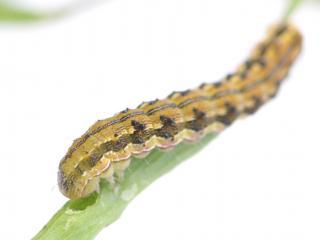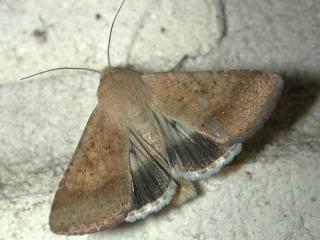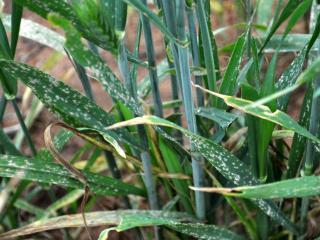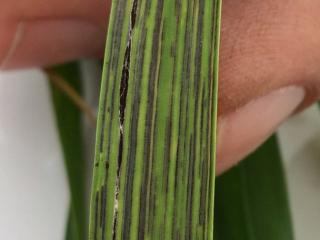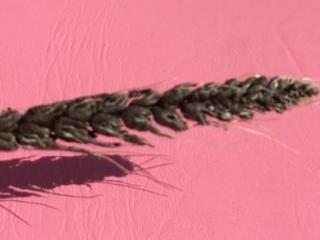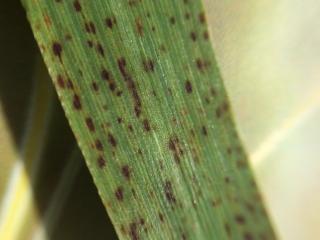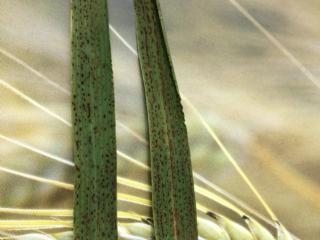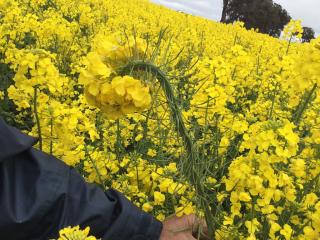Native budworm moth update
Caterpillar activity
- Maya
- Tammin
- Dale
- Aldersyde
- Wyalkatchem
- Cadoux
- Kellerberrin
- Bolgart
- Calingiri
- Toodyay
- Northam
- York
- Corrigin
A farmer near Maya used a sweep net to monitor a lupin crop at the leaf drop stage and found, on average, one budworm caterpillar per 10 sweeps, however he noticed that quite a few pods had surface chewing damage. He then selected a number of plants and shook them into a large container, the subsequent calculations indicated there were 12 budworm grubs per square metre in the crop.
David Stead (Anasazi Agronomy) reports finding 10-25 budworm caterpillars per 10 sweeps in canola crops north of Tammin, eight caterpillars per 10 sweeps near Dale and 7-12 caterpillars per 10 sweeps in canola near Aldersyde. David has also been hearing of budworm caterpillars in lupin crops at Wyalkatchem and Cadoux.
A farmer and budworm trapper south of Wyalkatchem has used a sweep net to monitor a lupin crop and found above threshold numbers of budworm caterpillars earlier this week. A control spray will be applied over the weekend.
A farmer south of Kellerberrin reports finding 3-5 grubs per 10 sweeps in canola and lupin crops.
A GRDC GrowNotes Alert was distributed this week urging growers to check pulse and canola crops in northern and some central cropping areas of WA for above threshold levels of budworm caterpillars. This has prompted Twitter reports of budworm caterpillars being generally widespread throughout the areas of Bolgart, Calingiri and Toodyay.
Technical officer Dave Nicholson (DPIRD) has found the following numbers of budworm caterpillars (all less than 1cm long) in 10 sweeps in podding lupins: one at Northam, 60 at York and one at Corrigin. He found none in late flowering/podding canola at Wickepin and Pingelly.
As lupins near maturity it can be difficult to use a sweep net as the plants are stiff and the pods are spiky. An alternative to sweeping is to cut plants from several places in the crop and shake them into a bin to count caterpillar numbers. Taking small areas from the crop, say a quarter or a tenth of a square metre, or a number of plants equal to that found in a square metre, is the easiest method for assessing damage levels for the entire crop. Narrow-leafed lupin crops will not be damaged until they are close to maturity and the pods are losing their green colouration. Pod walls are not penetrated until the caterpillars are over 15mm in length. Budworm caterpillars will continue to cause damage to lupins until the seed is near the hard ripe stage
With canola and pulse crops smaller caterpillars are able to easily chew into the thinner pod walls. Native budworm can also cause damage after a canola crop has been swathed. This will occur if the crop is swathed when many pods are still green with soft seed. Seed damage from native budworm increases in swathed crops if drying is prolonged due to cool damp conditions.
Native budworm moth surveillance
- Usual automated and manual trapping locations
The larger native budworm moth flights recorded by budworm trappers this week include; Dowerin (821 moths over 14 days), Kojonup South West (460), Pingrup (390 over 14 days), Merredin South (286), Cuballing (270), Varley (256), Binnu (232), Kellerberrin South (230 over 14 days), Doodlakine South (220), Wyalkatchem S (170) and Badgingarra North East (164).
Results of this week's automated and manual trappings are available at the department’s Native budworm moth numbers 2018.
A mapped view of the native budworm trap captures is available at cesar’s MothTrapVisWA page. Viewers need to select the desired trapping date range.
For more information on native budworm refer to DPIRD’s 2018 PestFax Issue 22 article Native budworm moth flights are increasing in numbers and distribution and Management and economic thresholds for native budworm page.
Be mindful of withholding periods near harvest
Farmers with native budworm caterpillars in their crops need to be mindful of insecticide withholding periods (WHP) close to harvest and remember that windrowing is classified as harvest.
For more information on insecticides refer to the department’s Winter/Spring Insecticide Spray Chart 2018.
For more information contact Alan Lord, Technical Officer, South Perth on +61 (0)8 9368 3758 or +61 (0)409 689 468.
Barley and wheat disease update
Powdery mildew in wheat
- Coomalbidgup
Plant pathologist Andrea Hills (DPIRD) reports finding powdery mildew in flowering Scepter wheat near Coomalbidgup. Up to 60% of the crop was infected. The crop had been sprayed but the powdery mildew was reappearing. When Andrea checked DS Pascal wheat in the neighbouring paddock powdery mildew was noticeably absent. The Pascal wheat was at dough development.
DS Pascal is rated as being resistant (R) to powdery mildew while Scepter is moderately susceptible to susceptible (MSS). Selecting wheat varieties with even moderately resistant to moderately susceptible (MRMS) resistance provides useful disease protection.
For more information on diagnosing and managing this disease refer to DPIRD’s Managing powdery mildew in wheat page.
Flag smut of wheat
- Cadoux
David Stead (Anasazi Agronomy) reports finding flag smut in Mace wheat near Cadoux.
Mace is rated as being susceptible (S) to flag smut.
Infected wheat plants leaves, leaf sheaths and occasionally stems have long grey-black streaks with powdery black spores (which rub off easily) on them.
Spores of the fungus can survive in soil for up to seven years. In paddocks contaminated with flag smut, use clean fungicide-treated seed of resistant varieties the following season to reduce disease risk. Disease rating information for varieties can be checked in DPIRD’s wheat disease ratings.
The disease is also well-managed by fungicide seed dressing
For more information refer to DPIRD’s Diagnosing flag smut of wheat and Smut and bunt diseases of cereal - biology, identification and management pages.
Covered smut in barley
- Westcliffe
Development officer Stacey Hansch (DPIRD) has found covered smut in flowering Spartacus barley near Westcliffe.
Infected barley heads may emerge slightly later than healthy heads and become trapped in the boot and emerge from the leaf sheath below the flag leaf. All of the grains in an infected head are replaced by brown-black masses of spores.
The smut masses do not break up readily or blow away as happens with loose smut. The smut spores are released during harvest and contaminate clean seed, machinery and soil. The presence of barley smut may downgrade quality or exclude barley from delivery.
This disease is well-managed by regular application of fungicide seed dressing, selecting resistant varieties, using uncontaminated seed and paddock rotation. Variety information is available in DPIRD’s barley variety guide.
There are a number of different smut diseases of cereals and their identification is important.
For more information refer to DPIRD’s; Diagnosing covered smut in barley and Smut and bunt diseases of cereal - biology, identification and management pages.
Physiological leaf spotting symptoms look similar to spot-type net blotch
- Westcliffe
Development officer Stacey Hansch (DPIRD) recently found physiological leaf spotting (PLS) in Flinders barley near Westcliffe. The crop was at ear emergence. It was originally suspected that it might be spot-type net blotch (STNB). However the numerous small, dark spots are characteristic of a PLS type reaction in Flinders.
Plant pathologist Andrea Hills (DPIRD) advises that the presence of small dark coloured spots on leaves should not always be presumed to be STNB.
PLS is a response to an abiotic stress (that is, not a pathogen) and is not thought to affect yield. Spot symptoms differ with barley varieties, for example, infected Stirling barley plants have very small pale to orange pinprick spots while Vlamingh barley spots are 1-2mm, brown to dark brown spots that may increase in size. Spots most commonly develop from stem elongation to flag leaf emergence. The most common type of PLS symptom seen in barley is a ‘thumbprint’ or smudge which tends to occur on the margins of leaves.
Sometimes small dark spots are the start of STNB but in the case above, the variety, number of spots and the fairly linear distribution of spots along the leaf blade distinguishes them as PLS.
Boron toxicity (from alkaline soils) also causes dark spots but these are usually (but not always) on the margins of leaves.
It is recommended that where there is any doubt about the cause of cereal leaf spotting then confirmation that it is a fungal disease should occur before any foliar fungicides are applied. Assistance with disease identification can be obtained from DDLS - Plant pathology services (phone +61 (0)8 9368 3351), this is a chargeable service, and can be worthwhile to avoid unnecessary application of fungicide.
Growers can also use the PestFax Reporter app to diagnose symptoms.
For more information see DPIRD’s Diagnosing physiological leaf spot in barley.
For foliar fungicide information refer to the department’s Registered foliar fungicides for cereals in Western Australia page.
For more cereal disease information contact Kithsiri Jayasena, Plant Pathologist, Albany on +61 (0)8 9892 8477, Geoff Thomas, Plant Pathologist, South Perth on +61 (0)8 9368 3262 or Andrea Hills, Plant Pathologist, Esperance on +61 (0)8 9083 1144 or Ciara Beard, Plant Pathologist, Geraldton on +61 (0)8 9956 8504.
Fasciation found in canola
- Kojonup
- Katanning
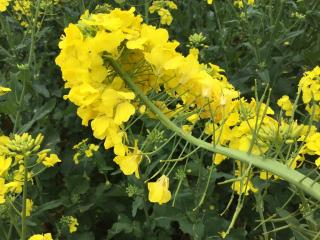
Fasciation in canola has been observed by plant pathologist Ravjit Khangura (DPIRD) in flowering GT53 canola at Kojonup and in an unknown variety at Katanning.
Fasciation is a condition where flowering heads and in some instances lower stems get flattened and ribbon like and is also characterised by the presence of abundant flowers and pods on plants.
Fasciation is not common in canola, occasionally some odd plants are seen with this disorder. The actual cause of fasciation is unknown; it could be due to mutation or environmental factors.
Apparently some canola varieties are more susceptible than others to develop fasciation.
Fasciation is unlikely to impact canola yields. There is no known risk of carryover to subsequent canola crops.
For more information on fasciation see the department’s Diagnosing fasciation in canola page.
For more information on fasciation contact Ravjit Khangura, Plant pathologist, South Perth on +61 (0)8 9368 3374.

